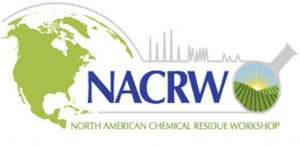By Sareeta Nerkar
 The North American Chemical Residue Workshop (NACRW), formerly known as the Florida Pesticide Residue Workshop, was held in Naples, Florida. For the 56th consecutive year, laboratory professionals met to discuss the latest trends in the analysis of pesticides, veterinary drugs and other chemical residues. The big topics at this meeting were cannabis analysis, novel and emerging contaminants in drinking water and food matrices, and finally trends in veterinary drug residue control. Sareeta Nerkar and Maria Ofitserova both attended this year, representing Pickering Laboratories at our booth and in several key technical and vendor presentations.
The North American Chemical Residue Workshop (NACRW), formerly known as the Florida Pesticide Residue Workshop, was held in Naples, Florida. For the 56th consecutive year, laboratory professionals met to discuss the latest trends in the analysis of pesticides, veterinary drugs and other chemical residues. The big topics at this meeting were cannabis analysis, novel and emerging contaminants in drinking water and food matrices, and finally trends in veterinary drug residue control. Sareeta Nerkar and Maria Ofitserova both attended this year, representing Pickering Laboratories at our booth and in several key technical and vendor presentations.
Broader acceptance of cannabis for medical use has increased the need for analytical methods capable of determining the active compounds as well as methods to detect contaminants such as pesticide residues, mycotoxins and traces of organic solvents. Cannabinoids are a class of terpenophenolic compounds that are associated with the pharmacological activity of cannabis. Cannabinoids exist in the plant mainly as carboxylic acids that are not physiologically active. The compounds are converted to neutral analogs by light and heat while in storage or during the preparation of edible products. Acids are also converted to their neutral analogs during GC analysis, which often causes differences in testing results when compared with HPLC analytical methods.
 Pickering Laboratories has developed a new post-column derivatization method to analyze cannabinoids in cannabis plants and cannabis-containing edible products. This post-column method is based on reaction with Fast Blue Salt reagent under basic conditions, a well-known color-forming reaction that is used in drug tests to detect cannabinoids via test-tube methods and thin-layer chromatography. After derivatization, detection at 475 nm is performed using a UV/Vis detector. The same post-column method was used for analyzing cannabinoids in hemp but with a modified sample preparation procedure that was easier and faster.
Pickering Laboratories has developed a new post-column derivatization method to analyze cannabinoids in cannabis plants and cannabis-containing edible products. This post-column method is based on reaction with Fast Blue Salt reagent under basic conditions, a well-known color-forming reaction that is used in drug tests to detect cannabinoids via test-tube methods and thin-layer chromatography. After derivatization, detection at 475 nm is performed using a UV/Vis detector. The same post-column method was used for analyzing cannabinoids in hemp but with a modified sample preparation procedure that was easier and faster.
At the NACRW conference, there was considerable interest in the Pickering Laboratories methods for testing cannabinoids and mycotoxins in hemp because they are simple, robust and economical.
Sareeta Nerkar enjoyed giving her oral presentation on Improved Extraction and Cleanup Prior to HPLC Determination of Glyphosate in Food Samples! Her talk presented a simple and robust post-column method for the analysis of Glyphosate at sub-ppm levels in many different types of foods. The method’s accelerated sample preparation improves throughput of the samples and reduces testing costs for busy laboratories. Many laboratories are looking for accelerated sample preparation and analysis of glyphosate at low levels with no matrix interferences, and Pickering Laboratories has the answer!
Sareeta also shared her poster on Analysis of Mycotoxins in Cannabis Plant and Cannabis-containing Products, which was well received. Please always feel free to contact us for more information or check out our webpage.
Pickering Laboratories sponsored a lunch vendor seminar during tne conference, where Maria Ofitserova introduced the Onyx PCX, the newest addition to our integrated family of post-column derivatization instruments, chemistry and support. The seminar included all the Onyx PCX instrument features as presented by Maria, then Sareeta followed up by presenting our latest research and method development on hemp!
All of the Pickering Laboratories presentations are available on the NACRW website. Overall, Maria and Sareeta had a great conference and really appreciated all of your interest in our latest Onyx PCX and new post-column methods and applications!

 Two of our research chemists will be traveling to Naples, Florida from July 21-24, and they hope to get a chance to meet customers face-to-face and compare notes on the latest research and upcoming industry needs! Sareeta Nerkar will be joined by Maria Ofitserova in representing Pickering Laboratories at the meeting. In addition to sponsoring a luncheon, Sareeta and Maria will be hosting a vendor seminar on Wednesday, July 24 that will include the latest post-column applications, including Mycotoxins Analysis in Hemp and additional exciting news.
Two of our research chemists will be traveling to Naples, Florida from July 21-24, and they hope to get a chance to meet customers face-to-face and compare notes on the latest research and upcoming industry needs! Sareeta Nerkar will be joined by Maria Ofitserova in representing Pickering Laboratories at the meeting. In addition to sponsoring a luncheon, Sareeta and Maria will be hosting a vendor seminar on Wednesday, July 24 that will include the latest post-column applications, including Mycotoxins Analysis in Hemp and additional exciting news.